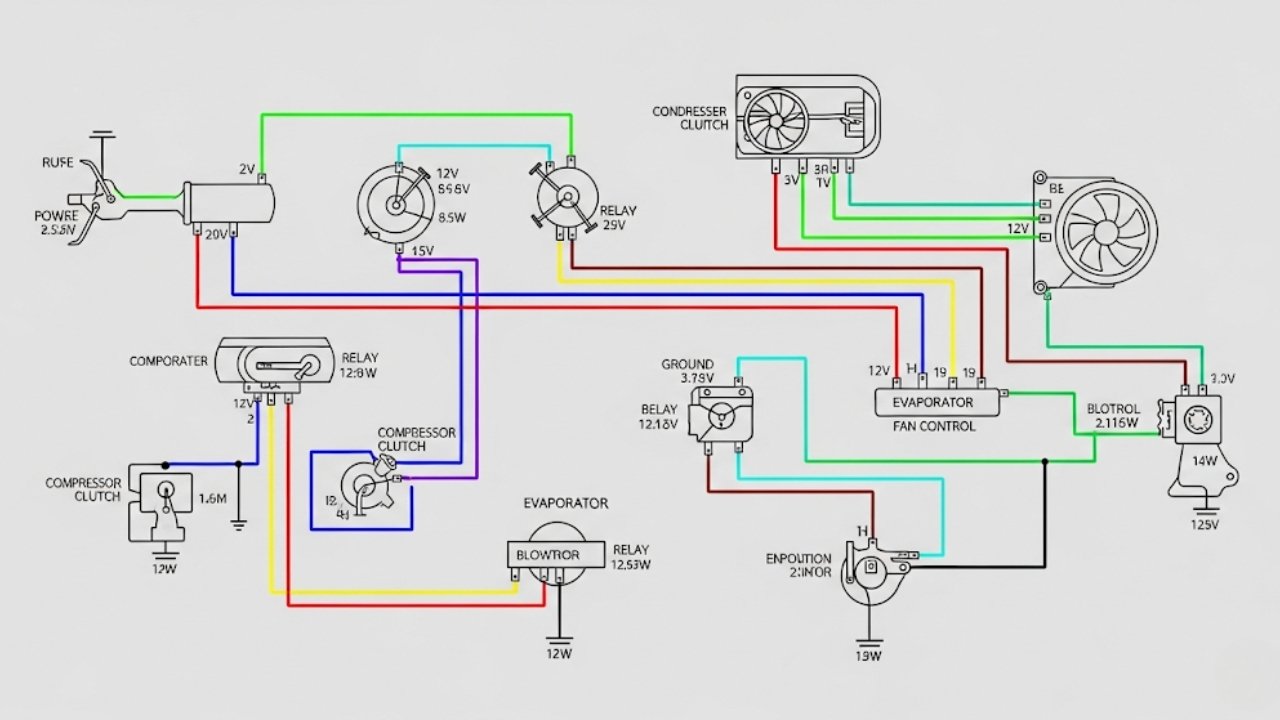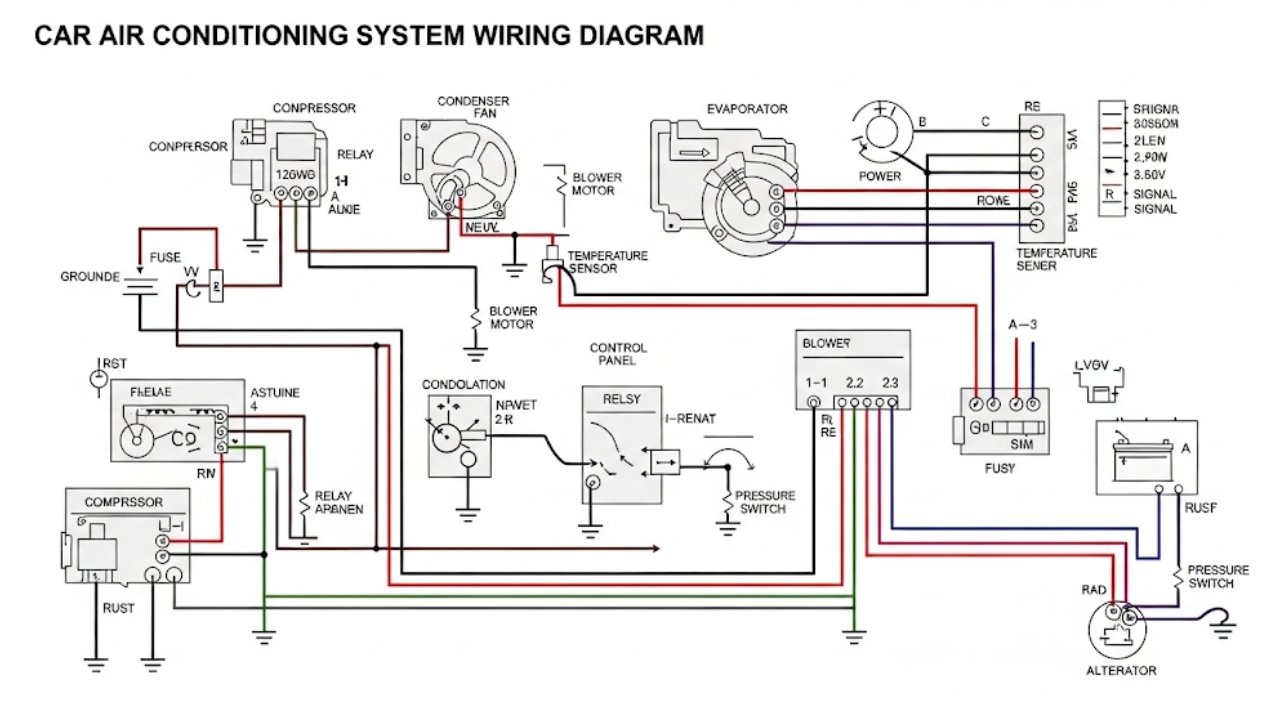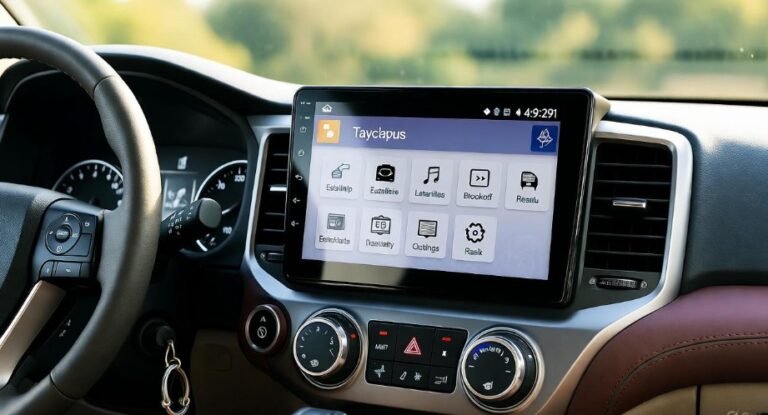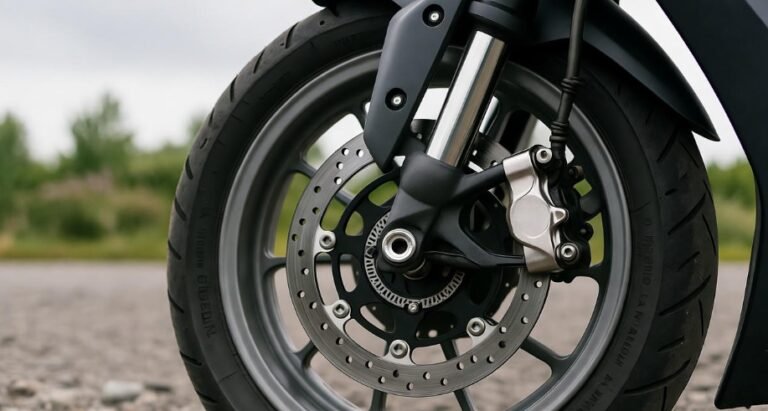Car Air Conditioning System Wiring Diagram

Introduction: Why Understanding Your Car’s AC Wiring Matters
Imagine driving on a hot summer day—windows up, sun blazing, and suddenly your car’s air conditioner stops working. You fiddle with the controls, but nothing helps. Sound familiar? You’re not alone. Many car owners feel helpless when their AC fails. But what if you could actually understand what’s going wrong?
That’s where a car air conditioning system wiring diagram comes in. It’s like a roadmap for your vehicle’s cooling system. Whether you’re a DIY enthusiast or just curious, learning how your AC wiring works can save you time, money, and stress.
Understanding this wiring diagram is like unlocking a hidden blueprint. It lets you troubleshoot, pinpoint faulty connections, and maybe even fix it yourself without rushing to a mechanic. This article will walk you through everything—from basics to advanced tips. Ready to dive in? Let’s get cool—literally.
What Is a Car Air Conditioning System Wiring Diagram?

Most wiring diagrams will include:
-
Compressor clutch
-
Pressure switches
-
Thermostat
-
Blower motor
-
Relay systems
-
Power source (battery or ignition)
These diagrams help you trace power flow and locate issues such as:
-
A blown fuse
-
A bad ground wire
-
A malfunctioning switch
-
A shorted-out relay
They’re not just for mechanics. Even if you’re not tech-savvy, understanding a few lines and symbols can help you figure out why the cool air isn’t blowing like it should.
And here’s the kicker—almost every car brand has a slightly different layout. That’s why referring to the exact car air conditioning system wiring diagram for your vehicle is crucial. It’s like trying to use Google Maps for New York when you’re in London—it just won’t help.
Main Components Involved in the Wiring Diagram
To truly understand the car air conditioning system wiring diagram, you need to get familiar with the major players. Each part is connected, just like instruments in a band working together to create a smooth melody. If one stops, the whole system goes off-key.
Here’s a breakdown of the major components:
1. Compressor Clutch
This is the heart of the AC system. It turns on and off based on signals it receives through wiring. It draws power directly from the battery via a relay or fuse.
2. Blower Motor
This pushes the cold air through your vents. Controlled via switch and resistors, it’s wired to the control panel and relays.
3. AC Control Module
This is the “brain.” It reads inputs from various sensors and sends output signals to actuators and relays.
4. Thermostat & Pressure Switches
They tell the system whether it’s safe to keep running. If the pressure is too high or low, they cut off power to the compressor.
5. Fuses and Relays
Fuses protect the wiring from overload. Relays act like remote-controlled switches—they allow low power switches to control high power components.
Understanding how these connect within the car air conditioning system wiring diagram helps you trace problems back to their source.
How Power Flows Through the AC System
Let’s break down how electricity flows through a typical car’s AC system in simple words:
-
Power Source: It all starts at the battery.
-
Fuse/Relay: Current flows through a fuse and AC relay.
-
Control Panel: When you hit the AC button, the control panel sends a signal to activate the relay.
-
Compressor Clutch: If the pressure and temperature conditions are safe, the relay activates the clutch.
-
Blower Motor: Simultaneously, the blower starts pushing air through the cooling system.
Here’s a simple table to illustrate the power path:
| Component | Power Input Source | Triggering Condition | Output Action |
|---|---|---|---|
| AC Compressor | Battery via Relay | Low/High pressure + AC command | Starts or stops cooling |
| Blower Motor | Ignition Power | Fan Speed Selector | Pushes air through vents |
| AC Relay | Battery | Activated by Control Panel | Switches compressor ON/OFF |
| Pressure Switch | Inline Circuit | Checks refrigerant pressure | Cuts off compressor when unsafe |
Once you understand this flow, reading a car air conditioning system wiring diagram feels like reading a comic book—with wires instead of speech bubbles.
Reading a Wiring Diagram: Symbols You Should Know
Wiring diagrams are full of mysterious symbols. But don’t worry, they’re easier to learn than traffic signs. Here’s a quick cheat sheet of the most common ones:
-
Solid line: wire or electrical path
-
Dotted line: usually represents optional or variable connection
-
Triangle: ground
-
Wavy line: resistor or blower motor
-
Switch symbol: shows whether it’s normally open or closed
-
Rectangle: control module or relay
Once you recognize these, your diagram begins to make sense. It’s like decoding a secret language—one that helps you fix your AC faster and smarter.
A great tip is to follow one circuit at a time. If your compressor isn’t kicking in, start tracing its line back to the fuse, then to the relay, and so on.
Common Issues Spotted Using a Wiring Diagram
Now that you know how to read a car air conditioning system wiring diagram, here’s where it becomes super useful. You can now troubleshoot like a pro. Here are the most common issues you can find:
1. Blown Fuse
You might notice the blower fan not running. A quick check on the fuse box (visible in the wiring diagram) can confirm this.
2. Faulty Relay
If the compressor won’t turn on but the fuse is fine, the relay might be to blame. Swap with another similar one to test.
3. Broken Ground Wire
No ground = no power flow. Wiring diagrams help you find where the ground should be and test it with a multimeter.
4. Faulty Pressure Switch
These switches often interrupt the compressor circuit. The wiring diagram will help you locate and test these connections.
Using this visual guide helps you narrow the issue quickly, saving you hours at the mechanic or hundreds in service charges.
Different Car Brands, Different Wiring Layouts
When it comes to car air conditioning system wiring diagrams, not all cars follow the same pattern. Each manufacturer has their own logic, layout, and wire color codes. A Chevy diagram will differ from a Honda, and a BMW’s wiring will feel like a puzzle compared to a Ford’s.
For instance:
-
Chevy AC systems often use color-coded wires with dedicated fuses and relays for both blower and compressor.
-
Toyota models integrate the AC control system with the ECU (Engine Control Unit), which means more complexity.
-
European brands like Mercedes or Audi sometimes use multiplexed systems where AC signals are sent over data buses, not traditional wires.
So, before you attempt a repair, always reference the correct wiring diagram for your car model and year. You can often find this in:
-
Your vehicle’s service manual
-
Manufacturer websites
-
PDF files on auto repair forums
-
Trusted platforms like wirecrafted.com or kdi-ppi.com
Using the wrong diagram is like using a London subway map in Tokyo—useless and confusing.
How to Create or Trace Your Own AC Wiring Diagram
Sometimes, finding the exact car air conditioning system wiring diagram online isn’t easy—especially for older cars or imported models. But don’t worry. With some basic tools and patience, you can create or trace your own simplified wiring diagram.
Here’s how:
-
Start at the Battery
Trace the power wire going to the fuse box. Follow the circuit going to the AC components. -
Use a Multimeter
This helps check which wires carry voltage. Mark them. -
Label Each Component
Draw squares for relays, circles for motors, and triangles for grounds. -
Draw on Paper or Software
You can sketch it manually or use software like Lucidchart or EasyEDA. -
Color-Code the Wires
Use different pens to mark power, ground, and signal wires.
This method gives you a clear visual map of how your specific AC system works. It’s a bit like drawing your own treasure map—just instead of gold, you find cold air.
DIY Troubleshooting Using Wiring Diagrams
You don’t have to be a professional mechanic to use a car air conditioning system wiring diagram for troubleshooting. Here’s a simple step-by-step guide anyone can follow:
Step 1: Identify the Problem
-
Is the fan not blowing?
-
Is the air warm instead of cold?
-
Does the AC turn off randomly?
Step 2: Check Fuses First
Look at the fuse marked “AC” or “HVAC” on the wiring diagram. Use a test light or multimeter.
Step 3: Test the Relay
Using the diagram, locate the relay controlling the compressor. Listen for a clicking sound when AC is turned on. If not, swap the relay with a known working one.
Step 4: Inspect Pressure Switches
Trace wires from the compressor clutch to the low/high-pressure switches. Jump these connections (temporarily and safely) to see if the compressor kicks in.
Step 5: Check Ground and Voltage
Follow the ground path in the diagram. Use a multimeter to test if it’s still connected properly. Then check for 12V at key points like the blower motor or compressor.
Wiring diagrams remove the guesswork. They help you go from “I don’t know what’s wrong” to “Ah, this switch is bad.” And that kind of confidence? Priceless.
Tips for Working Safely with AC Electrical Systems
Before you start poking around wires, keep these safety tips in mind:
-
Disconnect the battery before testing wires directly.
-
Use insulated tools to avoid accidental shorts.
-
Don’t bypass relays or fuses permanently. Temporary testing is fine, but leaving it that way can lead to bigger problems.
-
Label everything you disconnect so it’s easier to reconnect later.
-
Wear safety glasses, especially if you’re near the compressor or refrigerant lines.
Working on your AC system can be rewarding, but safety always comes first.
Printable PDF Wiring Diagrams: Why They Matter
Many car owners search for a car air conditioning system wiring diagram PDF—and with good reason. Printable diagrams offer big advantages:
Benefits:
-
Offline Access: No internet needed in the garage.
-
Highlighting Areas: Mark bad circuits or fuses.
-
Larger View: You can print on A3 paper for better visibility.
-
Keep a Hard Copy: Tape it inside your garage door or toolbox.
Websites like wiringtrust.com and eleccircs.com provide downloadable PDF diagrams for hundreds of models. Just make sure to get the correct year, trim level, and engine type.
Car Air Conditioning with Battery Setup Explained
Some diagrams include a section labeled “car air conditioning system wiring diagram with batteries.” This usually refers to direct power from the battery (rather than through the ignition).
In such setups:
-
The battery powers the AC system directly through a relay.
-
It often includes a cutoff or safety switch to prevent battery drain.
-
Useful in RVs, modified vehicles, or emergency vehicles that need to keep cool even when the engine is off.
If your vehicle uses this system, be extra careful. Leaving the AC on could drain the battery in under an hour.
How AC Wiring Ties into Other Systems
Modern vehicles often have AC wiring integrated with other systems like:
-
The Engine Control Module (ECM)
The ECM adjusts idle speed and fuel mapping when the AC is on. -
Sprinkler-style Vent Control
Some diagrams may even say “wiring diagram for sprinkler system,” which actually refers to electronic vent actuators controlling airflow like a sprinkler pattern. -
Smart Climate Control Systems
Advanced systems use temperature sensors, sunlight sensors, and load calculators to decide how the AC behaves.
Understanding how AC wiring fits into the bigger system helps you fix issues that might seem unrelated—like rough idling or hot air at idle.
FAQs about Car Air Conditioning System Wiring Diagram
1. What is a car air conditioning system wiring diagram?
It’s a detailed map showing how each electrical part of the car’s AC system is connected—from the battery to the compressor and everything in between.
2. Why do I need to understand my AC wiring diagram?
Because it helps you find issues faster, understand power flow, and even perform simple DIY repairs.
3. Can I use a generic wiring diagram?
Not recommended. Use one that matches your car’s make, model, and year for accurate information.
4. What tools do I need to test AC wiring?
A multimeter, test light, wiring diagram, jumper wires, and sometimes a relay puller.
5. Is it safe to jump AC relays or switches?
Yes—for testing only. Never leave jumpers in place long-term.
6. Where can I find a diagram for my specific car?
Check your owner’s manual, visit trusted websites like wirecrafted.com, or buy a service manual online.
7. Can a wiring issue cause the AC to stop working completely?
Absolutely. A broken ground or blown fuse can shut down the entire system.
8. How long does it take to trace a wiring problem?
For simple issues—15 to 30 minutes. For complex ones, 1 to 2 hours depending on access and experience.
Final Thoughts: Know Your Wires, Beat the Heat
A car air conditioning system wiring diagram may look like a maze at first. But once you understand the flow, the symbols, and the logic—it’s like flipping on a light switch in a dark room.
Whether you’re fixing a broken AC, upgrading your setup, or just curious, this knowledge is empowering. It makes your car less of a mystery and more of a machine you understand and control.
Don’t be afraid to dig into your diagram. Study it, trace wires, check fuses, and test relays. The cool breeze that follows will be worth every minute.
And hey—next time your friend’s AC stops working, you just might become their hero.






